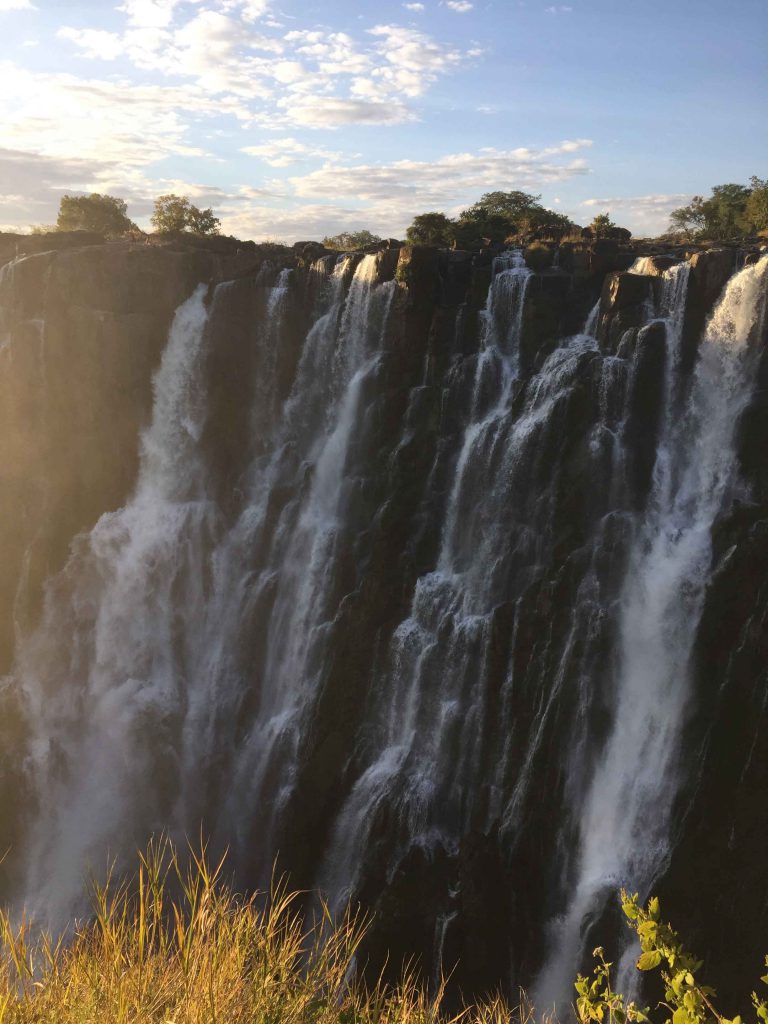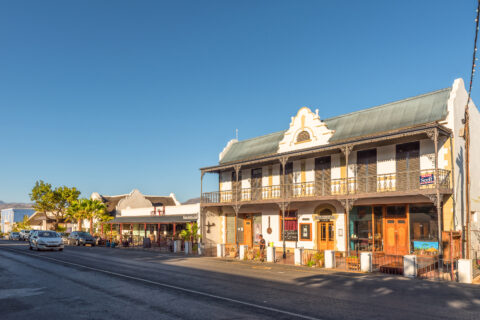Financial Mail Travel
Liquid Assets
The Zambezi River cuts through the dehydrated land like blue steel through biltong. The rains have not yet come; the bush along the M10 is rusk-dry, shades of stone and camouflage. The driver turns up the aircon and turns off at the signpost to Wilderness Safaris’ Toka Leya lodge. In no time, we’re in the shade of a hazy green oasis, watching the Zambezi coil lazily by.
Just 12km further downstream, this, the fourth largest river in Africa, pours itself over the mighty lip of the Victoria Falls and crashes 108m down to the Boiling Pot and Batoka Gorge. Yet here, upstream, the river is
a winking expanse, dotted with hippo pods and forested islands. A sunset cruise, is a languorous introduction to the river’s marvels. Elephant and other game sometimes frequent the banks to hose up precious water and bee-eaters hawk insects as we putter by. I’m oblivious to the power of the water below until we come across a boat with a stalled engine, being pulled inexorably downstream. It takes real effort to drag the craft back to the safety of the bank.
Livingstone was built on a rise 10km inland from the famous waterfall in efforts to escape malarial mosquitoes. Few escape the street vendors, who politely offer tourists copper bangles or small, carved charms of the Nyami Nyami, god of the Zambezi. A local told me that belief in the serpent-bodied, fish-headed deity was cemented during the construction of Kariba Dam in the 1950s when the dam cut off the male spirit from its female companion. In wrath, the god sent floods. The past decade, however, has seen more drought than floods and another dam due to start construction in 2020 is set to cause the river god (and the environment) further woe.
By the time I bunkered down at Toka Leya, I’d spoken to many people who’d shaken their heads over the missing rains. The river was much lower than usual for the time of year. The heavily protected rhino in the park were getting extra fodder; hydropower production was down. Inland, I’d seen village women and men loading oxcarts with water pumped from rare boreholes. Times were going to be hard for anyone who relied on the land. When crops failed people would be more than usually dependent on wild fruit and foods, such as monkey oranges, mongongo nuts and sour plums.
All of which made the breath catch in my throat as I approached the mystical Victoria Falls for the first time. I was expecting the enormous beauty of the falls, the overwhelming scale of its 1 700m-long curtain. But the sheer volumes of water, spooling in joyous freefall as spray rained down, and blew up and sideways, drenching anyone without a poncho? Over 500 million litres per minute during high water, sometimes more; all that liquid, in heavenly excess, in a thirsty land.
I went back to the falls with a Toka Leya guide as rainbows danced around the cascade. We got properly wet crossing Knife Edge Bridge and tracing the paths on the knuckle of land on the other side. The rainforest (actually, “spray” forest) harbours turacos and wailing trumpeter hornbills and remarkable views of the Boiling Pot and 1905 bridge that crosses to Zimbabwe. The splendour is seasonal: by the end of the dry season, there can be no water falling over the sheets of rock on the eastern, Zambian side of the falls; whereas at high water, the spray can obliterate views. Then, the best thing to do is take to a microlight and fly over the chasm, straightthrough spray dubbed the Angel’s Kiss. A microlight pilot tells me passengers cry, and sing – and sometimes, find God.
Back at Toka Leya, the sense of refuge was all the stronger. Although it’s in a small national park called Mosi-oa-Tunya (The Smoke that Thunders, the same name locals bestow on Vic Falls), the wider Zambian environment shows signs of strain. Deforestation is an issue, and temperatures and water scarcity are expected to increase in the Zambezi Basin. So my back-of-house tour of Toka Leya took on extra importance. John Yombwe, 32, once worked on construction and then maintenance at the lodge. We began talking, rather awkwardly, about human waste and septic tanks, and moved on to the intricacies of bioreactors, anaerobic bacteria and settling tanks. Toka Leya relies on the Zambezi for all the camp’s water, but treats every drop of grey water without chemicals. Pure again, the water is released back into the environment. This allows the luxury of occasionally watering the area around the lodge – making it an oasis for every bird and bushbuck in the vicinity. The water also feeds John’s many “children”: the indigenous trees in the nursery.
“Welcome to my beautiful paradise,” John says as we enter the potting shed, in which baby trees unfurl new leaves and stretch up. John learned about plants from his colleague, Donald Lisama, “the moving library”. At quiet times, the duo visits islands on the river and even sifts through animal dung and bird droppings to collect tree seeds. They have learned tricks: pierce hard baobab seeds to speed up germination; sow light leadwood seeds on gravel so they don’t rot. John shows me Natal mahogany, valuable African mangosteens (“Bob Marley trees” because they sport figs on “dreadlock” stems), and waterberries, which guard the river bank and prevent erosion.
Wilderness has planted over 16 000 trees around the lodge, in the Mosi-oa-Tunya park, and in the community, slowly rehabilitating denuded earth. The figure also includes trees donated to Greenpop to plant in Dambwa Forest. Schoolkids on Wilderness educational programmes sometimes help, as do staff and Toka Leya guests: I dropped a sturdy jackalberry into a pre-dug hole in the Zambian earth. Long may it grow.
“I feel like I am a creator,” says John. “You see the trees grow, birds appear, people eating the fruits, elephants… it makes me feel happy. It’s about fighting global climate change. We used to have rains in October and now they’re coming in January. By 2040, we don’t know what will happen… [That’s why] the sound of the river, the mighty Zambezi, is special. Once I hear the water flowing, I know there is life. Water is life.”
Towards the end of my time in Livingstone, I found myself below the crashing falls, enclosed by the black basalt walls of Batoka Gorge. All that water from the upper Zambezi charges through this channel, making for top-class white water rafting. We’d churned through the Terminator and Oblivion rapids, paddling and laughing. But at rapid #24, Safpar guide Melvin Ndelewa suggested jumping out of the raft. And so we did.
The Zambezi grabbed me as if it was a living being and I a mere chew toy. Buffeted by the tug and tussle of the water, slapped by waves and wonder, we shot downstream, past the rocks, carried by pure howling, anarchic force. Back in the boat, I shook the roaring water from my ears in awe. It was transformative: a once-in-a-lifetime awakening. I felt scrubbed clean, inside and out.






 Sign-up and receive the Business Media MAGS newsletter OR SA Mining newsletter straight to your inbox.
Sign-up and receive the Business Media MAGS newsletter OR SA Mining newsletter straight to your inbox.